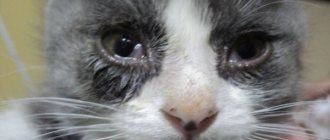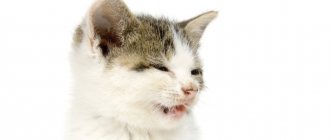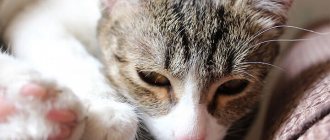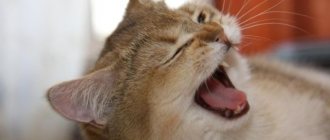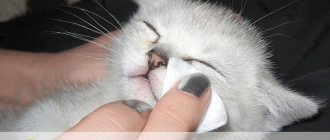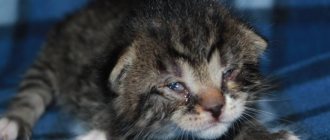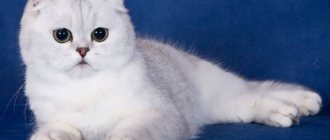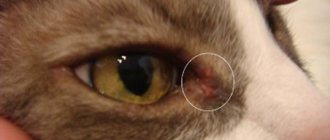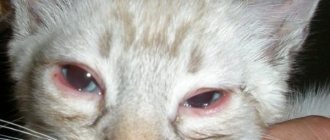Causes of pus in the eyes of cats
All causes of eye suppuration in cats can be divided into several large groups:
- Mechanical damage to the retina. Accompanied by temporary inflammation followed by watery discharge. The latter accumulate in the inner corners of the eye in the form of small, hard brown or black lumps.
- Chemical exposure that causes an animal to develop blepharitis (inflammation of the edges of the eyelids).
- Colds or allergies are often accompanied by clear or white mucous discharge from the nose and eyes.
- The body's response to the action of pathogenic microorganisms. The discharge is yellowish-green in color and is recognized by the specific smell of pus.
- The result of a complication of conjunctivitis that occurs when a veterinarian is not consulted in a timely manner.
- Helminthiasis. In addition to the main parasitic factor, helminths poison the animal’s body with the products of their vital activity. As a result, an allergic reaction occurs, accompanied by mucus from the nose and suppuration of the eyes.
We recommend reading the article about eye diseases in cats to understand the topic in more detail.
Causes and symptoms
Healthy animals also have discharge from their visual organs. As a rule, these are ordinary tears of a grayish, sometimes reddish hue. The reasons why they appear are different and there are quite a lot of them. If a cat's eyes are watery and purulent, this is not a cause for concern, especially if the discharge is rare and isolated. It is also worth considering the characteristics of the discharge. If simple tearing is normal, then the appearance of thick green or yellow pus is already an alarming sign.
First, let's figure out why a cat's eyes fester - what is the reason? After all, without understanding the cause, it is more troublesome to understand and cure the disease. Typically, these clear, watery discharges appear as a result of allergic reactions or mechanical damage. They may have a grayish or reddish tint.
Greenish or yellowish, thick, purulent discharge from a cat's eyes is considered a symptom of a bacterial or fungal infection. The disease cannot go away on its own, so these signs cannot be ignored.
Ocular and systemic diseases may be accompanied by purulent discharge from the cat's eyes. Eye diseases include:
- diseases of the cornea, eyelids;
- eye injuries;
- conjunctivitis.
Systemic diseases include chronic viral infections, panleukopenia or plague.
An attentive owner will quickly notice that the cat’s eyes are constantly festering, but in addition, the owner should be wary if the sick animal has additional symptoms indicating a problem:
- the animal looks worried, rubs its eye with its paw, refuses to eat;
- hides in dark places, body temperature may increase;
- the fur around the eye is felted and has a brown tint;
- the organ of vision is blurred and reddened.
You don't need a veterinarian's degree to understand that something is wrong with the animal. By the way, if you notice that your cat’s eyes are red and festering, redness does not have to be taken as a symptom of any illness. Most likely, this is a consequence of irritation of the eye with ichor, or the pet itself rubbed it with its paw, trying to get rid of the pain and itching that does not give rest.
When the first symptoms appear, the cat should be taken to the veterinarian in order to be correctly diagnosed and tested. To exclude conjunctivitis, the veterinarian performs a microanalysis of the cat’s eye mucosa and prescribes a comprehensive treatment. May prescribe antibiotic treatment - general therapy. For local therapy, ointments and eye drops are prescribed.
Bruise or injury to the eyelids is another important factor in the appearance of pus from the eyes. In this case, inflammatory processes are transmitted to the eyeball. You can get injured for various reasons: a fight, carelessness during the game and much more.
A cat can get blepharitis, which occurs due to traumatic, chemical, and thermal effects on the eyelids. The damaged area is an open door for germs, viruses, and pathogenic fungi that infect the eye.
Keratitis (inflammation of the cornea) is another disease that causes the cat’s eyes to fester.
Allergens – dust, perfume, pollen, medications.
There are many other reasons for the appearance of purulent discharge:
- dream;
- bad food;
- household chemicals;
- structural feature of the muzzle.
Symptoms
An experienced owner always pays attention to the behavior of his pet. Symptoms:
- Loss of appetite, general lethargy, increased sleep duration.
- Increased body temperature.
- Preference for dark, secluded places due to increased sensitivity to light.
- Squinting or closing your eyes most of the time.
- The presence of a specific odor.
- The appearance of a rare cough, redness of the mucous membrane, runny nose.
Diagnostics
If primary suppuration occurs, the owner should immediately contact a qualified specialist, preferably a specialist, an ophthalmologist. Time and strict adherence to the doctor’s instructions play an important role in the favorable outcome of treatment.
You should take eye diseases in newborn kittens especially seriously, because... complications later will pose an even greater danger.
Without laboratory tests and an integrated approach, it is impossible to be sure that the diagnosis is correct. Unfortunately, not all owners remember this, preferring self-medication at home to an experienced veterinarian.
Treatment methods
It is important to remember that the success of recovery directly depends on the accuracy of the diagnosis and the person’s willingness to fully comply with the instructions.
Recommendations:
- For a complete diagnosis, the doctor requires an anamnesis, i.e. information about the cat: what conditions the pet lives in, its diet, previous diseases, behavioral characteristics, proximity to other animals.
- It is advisable to wash your cat’s eyes with a warm chamomile solution before visiting the veterinary clinic.
- Depending on the causes of suppuration, the doctor may use several treatment approaches. In case of prolonged and profuse discharge from the eyes and nose, as a rule, a novocaine blockade with the administration of an antibiotic is prescribed. If discharge from the eyes is the result of mechanical damage, use Levomycetin drops for an adult cat or Albucid for one-month-old kittens.
What treatment is prescribed depending on the symptoms
Remember that any eye disease can lead to serious consequences. Therefore, it is important not only to recognize the disease in time, but also to choose the appropriate treatment. Of course, you should follow your veterinarian's recommendations.
Treatment of conjunctivitis
Before treatment, a festered eye must be treated with antiseptic substances: furatsilin solution or a pale pink solution of potassium permanganate. If the concentration of a solution of potassium permanganate can be determined by its color, then this cannot be done when using furatsilin. Therefore, to obtain a liquid with a weak concentration, it is usually recommended to dilute 1 gram of powder per five liters of purified water. This drug can also be purchased already diluted at the pharmacy.
Remember that a concentrated solution of potassium permanganate will dry out your pet’s skin, and undissolved crystals can even burn it
To make a weak solution of potassium permanganate, just add five crystals of the substance to one glass of water. At first glance, it seems that five tiny crystals of potassium permanganate will not be enough. But, as practice shows, this amount of manganese is quite enough to get a pale solution, as in the photo. The main thing is to thoroughly mix the crystals in the water. If you still went too far, as I did during my first “experience,” then you can always reduce the concentration of the solution with water.
After clearing the eyes of pus, you can proceed directly to treatment. Ointments have a thick consistency and therefore last longer than drops. They are usually applied no more than twice a day, and the course of treatment can last up to two weeks. The following drugs are suitable for these purposes:
- Tetracycline ointment;
- Erythromycin ointment;
- Levomycetin ointment;
- Sofradex;
- Misofen;
- Optimmune.
Anti-inflammatory drops are also used in the treatment of conjunctivitis. They are instilled three to six times a day, 2-3 drops into the affected eye. The full course of treatment takes up to three weeks. Some of the common drugs are:
- Dexamethasone;
- Leopard;
- Iris;
- Conjunctivitis;
- Lacrican;
- Lacrimin aseptic;
- Tsiprovet;
- Dekta;
- Barrier.
Drops are less effective because they have a liquid consistency and are quickly washed out of the eye, but they are a little easier to apply. The frequency of use of the drug will depend on the degree of eye inflammation and the doctor’s recommendations. In addition, before using the medicine, read the instructions for it.
Purulent, phlegmonous and follicular conjunctivitis is often treated with antibiotics. The latter are prescribed by a veterinarian in the form of injections intended for intramuscular administration. The treatment regimen prescribed by the doctor directly depends on the type of inflammation, so self-medication in this case is not allowed. You can also consult a veterinarian about a combination of traditional methods and store-bought drugs. Most often, such treatment is permitted and brings excellent results.
If the inflammatory processes are caused by an allergic reaction, then first of all it is important to eliminate the allergen, and then purchase antihistamines for the cat.
Video: treatment of conjunctivitis
Treatment of blepharitis
Blepharitis is treated in two ways: symptomatically and comprehensively. The appropriate method will depend on the extent of the disease and the damage sustained. In advanced stages, surgery cannot be avoided. Depending on the nature of the disease, antifungal, antiparasitic and anti-inflammatory drugs are used. Bacterial blepharitis is treated with antibiotics.
Treatment of keratitis
The method of treating keratitis will depend on the cause of its occurrence. The therapeutic method is suitable in the initial stages of keratitis development. Surgical intervention is necessary for serious damage and defects of the cornea. A combination of the methods described above is also possible.
Keratitis and blepharitis are also inflammatory diseases, so the same drugs can be prescribed for their treatment as for conjunctivitis.
How to apply ointment correctly
It is important to remember that it is not recommended to apply the ointment with your fingers, even if you have thoroughly washed your hands before. It’s better to buy a special glass rod with a rounded tip in the store. Or better yet, two - one for each eye of the pet. After use, the sticks should be treated with boiling water. The ointment is applied as follows:
- Wash your hands thoroughly.
- Lay your pet down so that his head is facing up.
- Immobilize your pet's head (it's good if someone helps you hold the cat).
- Warm the tube of ointment in your hands.
- Apply a small amount of ointment to the tip of the glass rod.
- Lift your pet's upper eyelid.
- Place the ointment under the eyelid.
- Gently rub your eyelid.
- Repeat with the second eye.
If your cat is very active and you can’t gently lift his upper eyelid, then apply the ointment to the lower eyelid. In this case, the pet will independently distribute the ointment over the eye when it blinks. The main thing is to prevent your pet from wiping off the ointment with his paw.
How to put drops in a cat's eyes
Before using the drops, decide how submissive your pet is. If the cat is very active and resists any attempt to hold it in a certain position, then use a towel to immobilize it. You can also hold the cat by the withers while applying the drops. Using drops consists of the following steps:
- Wash your hands thoroughly.
- Place the cat on its side.
- Warm the drops in your hands.
- Gently open the cat's eye.
- Drop the drug into the inner corner, following the instructions.
- Let your pet blink.
- Repeat with the second eye.
List of recommended drugs
Based on the causes of the disease, the veterinarian most often prescribes the following medications:
- For bruises and injuries - drops of Levomycetin or Iris.
- For swelling - a solution of hydrocortisone and novocaine.
- For acute illness - intramuscular antibiotics.
Prescribing medications for an animal should only be done by a professional after a complete diagnosis. Self-treatment without the guidance of a veterinarian can lead to complications and irreversible pathologies.
How to treat a cat's eye when injured
If a cat's eye is swollen and festering after the pet visited the street, it may be due to injury. The animal could have gotten into a fight or injured its organ of vision on a twig. Most often in these cases, people start thinking about brilliant green or iodine. What can I say - this processing is acceptable, but it can only be trusted to a qualified person. After all, these liquids, if they get on the conjunctiva, can cause a painful shock in the animal and, worse, lead to irreversible pathological processes in the eye.
The next point is what to do if the organ of vision is also swollen. If a cat's eye is swollen and festering, there is a reason for this. For example, the combination of a swollen eye and oozing exudate often indicates that a foreign object has entered the eye area. In this case, it is not advisable to help the animal “at home”. After all, you don’t know what exactly got into your pet’s eye, what if it’s a thorn that pierced the cornea. Accordingly, removing a foreign object can lead to increased damage, which will definitely harm the animal.
Inflammation of the cornea is a little more harmless. If the disease is acute, then the cat’s eyes fester greatly, in this case you already know what to do - go to the veterinarian.
Tips for beginners when washing eyes
Eye washing is one of the most important points in the treatment and prevention of disease in any animal.
You can do the procedure yourself at home or go to a veterinary clinic. During a period of illness, a cat is most often reluctant to allow its owner to approach it.
Representatives of the Persian, British and Siamese breeds are especially capricious. In this situation, it is advisable to ask a family member to hold the cat's head during the procedure. It is best to secure it with a towel or diaper.
Recommendations:
- A folded cotton pad or a tight tourniquet is suitable for rinsing. It is better to avoid cotton swabs, as they do not absorb liquid well, have a relatively small surface and can damage the retina when the animal tries to escape.
- For sterility purposes, it is better to prepare separate dishes for washing each eye. For the same reason, you should use a cotton pad no more than once.
- It is not recommended to touch the inflamed surface with a dry disc.
- Hands must be washed.
- All solutions must be at room temperature.
- Keep in mind that a swollen area can often cause pain for your cat.
- The best treatment is comprehensive. After rinsing with the solution/drops, re-treat the inflamed area with ointment.
- You need to repeat washing as often as possible. Step-by-step instructions for washing eyes
- Fix the animal on its side, turning its head up, holding the chin.
- If a crust forms and the eye sticks together, soften the inflamed area with Vaseline oil. Using cotton wool soaked in 3% hydrogen peroxide, remove the discharge, then rinse with the solution and apply eye drops.
- Apply the solution to the eyeball, gently lifting the eyelids.
- Raise and lower the animal's eyelids several times to distribute the medication evenly. Remove excess with a disc.
- Do not forget about nasal discharge, remove it with a cotton pad.
Prevention and care for cat eyes
Why does a cat’s eyes water, what to do is clear, but is it possible to prevent this undesirable phenomenon? Daily morning exercise is necessary for your cat. What do we have to do?
First, you need to examine your pet's eyes and the area around them for damage. Afterwards, wash the cat thoroughly, removing all possible contamination. You should not wash cats with light fur with tea or herbal infusions - they can stain them.
It is better to use plain boiled water. By the way, there are special gels for animals and other washes for this. To wipe the areas surrounding the eyes, lotions created specifically for this purpose or weak green tea are used. Decoctions of sage or chamomile are also used for washing. After such procedures, it is better to dry the wool well.
Afterwards, the lower eyelids and nasolabial folds are treated with a gel that protects against various infections; this can be easily done with a cotton swab. It is completely safe for cats.
Does not dry out the mucous membranes of the eyes, does not damage the hair and does not cause allergic or inflammatory reactions. When finished, you should comb the cat thoroughly and scratch it behind the ear - she will be extremely grateful!
Types of tinctures and solutions
Eye solution can be purchased at a pharmacy or prepared independently.
The most effective are:
- Camomile tea. Dilute one tablespoon of dried flowers in a glass of boiling water. Leave for 30 minutes.
- A decoction of strong tea. It is advisable to use whole leaves and distilled water.
- Table salt solution. For a liter of distilled water, take 1/2 teaspoon of salt. The mixture is brought to a boil. Not suitable in case of an allergic reaction.
- Lacrimin or Medkinos solutions, which can always be purchased at a pharmacy at an affordable price.
The cat's eye is rotting
There are different tips on how to deal with pus in the eyes of cats, cats and kittens. All tips can be applied in practice, but any pet owner needs to understand that ignorance of the characteristics and causes of the problem can cause improper treatment and deterioration of the pet’s condition, so a trip to the veterinarian is mandatory in any situation.
It is recommended that you familiarize yourself with the questions that cat owners most often ask when pus appears in the eyes, so that you know what you have to deal with in practice.
The cat has a festering eye and nose, sneezing, runny nose
One of the reasons for sneezing, runny nose and purulent eyes in cats can be a cold. It is necessary to treat a cold animal by creating greenhouse conditions for it and improving its diet. Warming the nasal area with hot salt or sand wrapped in a piece of cloth and instilling a 1% soda solution into the nose helps eliminate a runny nose and sneezing. In the fight against conjunctivitis, eye drops and ointments are effective - sofradex, tetracycline, chloramphenicol. However, it will be much better if you hear such recommendations from the lips of a veterinarian.
The cat's eye is festering and does not open, the eyelid is swollen
If a cat’s eye is festered and cannot open, or the eyelid is swollen, then there is a high probability of a foreign body getting into the eye, which means that professional intervention is indispensable. Every hour of delay can result in deterioration of vision or its complete loss.
The cat's eye is festering, swollen and red, his cheek is swollen, what should I do?
The diagnosis of the disease with such serious symptoms can only be made in a veterinary clinic where there is special equipment. The cat may need to have an x-ray, an MRI, or a needle biopsy taken. To prevent the cat from scratching the tumor, it is necessary to wear a collar.
A cat's eye is festering after a fight, from birth what to treat and rinse, drip
Suppuration of a cat's eyes is often caused by a bacterial or viral infection, so curing only the external manifestations of the disease can only worsen the general condition of the animal. The nature of the disease is established after taking swabs from the conjunctiva. Based on the test results, the most effective treatment path will be chosen. When providing first aid to an animal, you can wash the eyes with a cotton swab dipped in solutions of furatsilin or pale pink manganese.
A cat's eyes are festering, treatment and how to treat it, what to apply at home
To treat purulent eyes, prepare a washing solution - dilute manganese to a pale pink color or furatsilin (1 tablet per 100 ml of water). The eyes are treated separately, each time using a new gauze swab (vyta fibers can cause additional irritation to an already inflamed eye). Direction: from outer corner to inner corner.
To apply eye drops, the animal is laid on its side and its head is turned up. All you have to do is gently hold your eyelids and drip in 2-3 drops of the medicine prescribed by your doctor.
The cat's eyes are festering, treatment with folk remedies
The most common folk remedy for eye suppuration is a decoction of the herbs chamomile, eyebright, calendula, or pharmaceutical hydrocortisone or tetracycline ointment,
The cat's eyes are festering, what drops to buy, tetracycline, albucid, antibiotic, chloramphenicol, sulfacyl
In principle, the listed medications - tetracycline, albucid, chloramphenicol and sulfacyl - are suitable for the treatment of suppuration in the eyes of a cat. To which of them the viruses and bacteria that cause the disease will be more sensitive, conclusions can only be drawn by analyzing the conjunctival wash.
The cat has festering eyes, does not eat or drink anything, is lethargic for a very long time, has no appetite, how to cure it
A panacea for all diseases has not yet been found, either for animals or for people. Symptoms when a cat’s eyes fester, he doesn’t eat or drink anything, is lethargic for a very long time, has no appetite, accompany many infectious and chronic diseases, which means a visit to the animal clinic cannot be avoided.
Why does a cat's eyes fester, causes, worms after injury and what to drip
The reason that a cat’s eyes are festering may be: - mechanical injury or bruise; - reaction to irritation by acids or toxic fumes; - disease caused by infection or helminths; - damage to the conjunctiva and penetration of pathogenic microorganisms into it; - an inflammatory process that affects areas adjacent to the eye. Instilling eye drops even with the best drug will not give the expected effect until the root cause of the disease is eliminated and cannot be done without the help of a veterinarian. Only a doctor can tell you what to drip in each specific case.
The cat has white pus in his eyes, how to help
If a cat develops purulent discharge from the eyes, the animal should be immediately shown to a veterinarian. As a first aid, you can wash your cat’s eyes with a chlorhexidine solution of 0.05% or with plain boiled water, and then drop a couple of eye drops - “Iris”, “Diamond Eyes” or “Leopard”, and blot the fur around the animal’s eyes dry with a napkin.
Is it possible to wash the cat's eye with chlorhexidine?
Chlorhexidine is a cheap and effective drug with an antibacterial effect. To wash the eyes, use a 0.05% aqueous solution of the drug. Note the difference - chlorhexidine is used as a rinse rather than as an eye drop. Those. A cotton swab is generously moistened in the solution and rubbed over the hair around the eyes in order to soak and remove dried purulent crusts.
A cat's eyes are festering, can a person become infected?
Purulent discharge from a cat’s eyes is a symptom of various diseases of a parasitic or infectious nature, so the possibility of human infection with them cannot be ruled out.
- 6 Comments
- 0 Trackbacks & Pingbacks
- Anna:
12/12/2016 at 18:26why does a cat hide his pus?
- Musya:
01/16/2017 at 20:10
The cat has a brown discharge from one eye. rubs with paw. the fur on the paw came off. how to treat the eye?
- Laysan:
05/22/2017 at 08:00
Yes, the eyes of all cats fester
- Natasha:
01/05/2018 at 23:00
Helped, thank you!!
- Anonymous:
05/11/2018 at 00:35
For what
- Lyudmila:
06/23/2018 at 00:51
Yes, all cats have problems
Add a comment Cancel reply
Choosing eye drops
Unlike infusions, it is impossible to prepare drops at home. You can find the necessary remedy at a veterinary or regular pharmacy.
It is important to remember that neither solutions nor drops can provide a 100% healing effect. The latter are necessary only to slow down the development of the disease.
The most commonly prescribed drugs are:
- Sulfacetamide.
- Levomycetin drops.
- Diamond eyes.
What to do and how to treat?
Before visiting the doctor, you can wipe your pet’s eyes with a herbal decoction.
If the owners notice that the cat’s eyes are festering and other alarming symptoms are recorded, then they should not delay a visit to the veterinarian. At home, it is possible to treat the visual organs with decoctions based on chamomile, calendula and other medicinal herbs that have antimicrobial and antiseptic effects. After conducting a comprehensive examination and identifying the root cause of the problem, the pet is prescribed medications.
You should not apply any eye drops to cats for pus at your own discretion, since there is a high probability of worsening the disease and developing complications. In most cases, it is possible to cope with unpleasant symptoms in a pet with the help of the following ophthalmic medications:
- "Iris";
- "Leopard";
- "Diamond Eyes";
- "Levomycetin".
For a speedy recovery of your pet and elimination of pathological exudate, you need to know how to properly apply eye drops to a cat. To do this, the pet's head is fixed so that the visual organs are directed upward. It is better to perform the manipulation together to ensure reliable fixation of the cat. The pipette must be kept at a distance of 2 centimeters from the eye, so that in case of sudden movement it does not damage the mucous membrane of the eye. Treatment is carried out until the animal recovers completely, until the discharge completely stops appearing.
Selection of ointments and method of their use
For best effect, it is recommended to use ointments. As a rule, tetracycline ointment (1%) is used.
Apply it as follows:
- First, purulent discharge from the eyes and nose is removed. Gently wash the inflamed areas with a cotton pad soaked in tincture or solution.
- To enhance the effect, the ointment is warmed to room temperature in advance.
- Lightly pull back the cat's lower eyelid, apply ointment to its inner surface, placing the latter with a special spatula.
- The eyelids are closed, massaging in a circular motion to better distribute the ointment over the surface of the swollen eye.
- Remove excess with a cotton pad.
Owner's first aid
Of course, when a cat has suppuration, a veterinarian’s consultation is necessary. Only after an examination can a veterinarian make an accurate diagnosis and prescribe appropriate treatment. However, the owner must also be able to provide first aid carried out at home. First of all, rinsing is necessary.
Eye wash
How can you wash your eyes?
- Decoction of chamomile flowers.
- Boric acid solution (2 teaspoons of medicine per half liter of warm boiled water).
- 0.02% solution of furatsilin.
Rinsing is best done together, one person should hold the animal and the other should carry out the procedure, this is necessary so as not to damage the pet’s eyes.
How to wash?
The basic rule: the solution must be warm, you cannot use it hot so that the animal does not get burned. A cotton pad, previously twisted into a tourniquet, is dipped into the medicine, which is then squeezed onto the cat’s diseased organ. You need to wash until all the pus is removed. After each wash, the cotton pads should be changed; it is best if the tourniquet is disposable.
You cannot use dry cotton wool, as it can further injure the eye. You should not replace a cotton pad with cotton swabs. Of course, they are more convenient to use, but the sticks pick up a small amount of solution. After you have finished rinsing, you need to put 1% Tetracycline ointment behind the eyelid.
We use ointment
How to apply ointment correctly?
Before applying the ointment, it must be warmed in your hands; there is no need to make investments with a cold composition:
- One person holds the cat tightly, lying on his side.
- The other, meanwhile, carefully pulls back the animal's lower eyelid.
- Use a special spatula to apply ointment to the lower eyelid.
- Then you need to close the eye and distribute the ointment with light massaging movements.
We use drops
What drops can be used to bury a cat?
In order to treat a cat, you can use different drops, for example, Levomycetin, Sodium Sulfacyl, Diamond Eyes drops.
How to carry out the procedure correctly?
- The cat needs to be laid on its side, and in such a way that the eyeball is directed upward.
- In order to administer the drops, you need to hold your pet firmly so that it does not get injured.
- Drop the medicine, after which the cat will blink vigorously, and the medicine will be distributed in the eyeball.
- Then blot the area with a napkin.
Preventive measures necessary to avoid eye diseases
Vaccinations and periodic deworming are universal ways to protect any animal. It is also important to consider the breed of the cat.
Some of them, such as the Sphynx, require increased attention to the skin. Having no fur, they are more susceptible to suppuration. Not only do they require daily care and eye washing, but they also need to repeatedly wipe their ears with a warm solution.
The opposite situation is the Persian breed with thick hair. In case of suppuration, snot and other mucous secretions, you should cut off the hair around the swollen organ and, after recovery, carefully ensure that the hair does not fall into the area of the former inflammation.
If infected, you should not allow the infectious animal to come into contact with your child or healthy pets; it is also important to remember your own safety measures when treating your eyes.
If the cause of eye discharge is an injury, then it is better to make an appointment with a veterinarian, undergo a full course of treatment, and also see a doctor regularly after that (preferably every month).
Daily animal care is the key to health. As a rule, it is difficult to train an adult cat to wash its eyes. However, for some breeds such safety measures are simply necessary due to their anatomical features, for example, Scottish Folds. Therefore, it is better to accustom your cat to such procedures from the first weeks of life.
Other causes of festering eyes
When the owner notices that the cat’s eyes are festering and the pet often sneezes, rubbing his nose from which snot flows, he can hardly immediately find out the cause of the sneezing and increased discharge. The same applies to the measures that need to be taken to stop the problem. Establishing the factor that caused this violation is a priority in this case.
Sneezing can be caused by ordinary dust. But if an animal sneezes constantly, this is an alarming symptom indicating illness and abnormalities in the body.
For example, if a cat has a runny nose and festering eyes, this is a common sign of a cold. It could also be an allergic manifestation to irritants or an infection.
Cat allergies are one of the most common causes of eye infections. Allergens are present everywhere:
- repellents for pests, mosquitoes, flies;
- perfume, household deodorants;
- cleaning and detergents;
- pollen of domestic plants;
- mold, fungi on the walls;
- cigarette smoke.
In addition to the main signs of allergies, such as when a cat’s eyes and nose fester, there are secondary symptoms of exposure to allergens:
- hoarse breathing;
- elevated temperature;
- general depressed state of the pet.
Each of these signs and all of them together is a reason to take the animal to the veterinary clinic. Doctors often encounter similar problems and know which antihistamine to prescribe when certain symptoms occur.
Important! It is worth understanding that if a cat’s eyes are festering due to allergies, it will not be possible to treat the problem with antihistamines. They temporarily stop the problem, but to save your pet from suffering forever, you will need to find the irritating allergen and get rid of it.
A cat's eyes fester for various reasons:
- poor health;
- reduced immunity;
- unkempt sleeping area;
- insufficiently balanced food.
Do not forget about hypothermia and drafts, because of which the cat’s eyes and snot fester especially often.
The first signs of a disease such as chlamydia are characterized by the appearance of purulent ichor and subsequent inflammation of the cornea and mucous membrane.
The next reason why a cat’s eye waters and festeres is atopic dermatitis. This is a seasonal disease of an allergic nature.
Do not discount such a factor as heredity. Cats whose family had ancestors suffering from eye diseases are at a special risk group; the likelihood of developing pathologies in these pets is 50% higher.
Sometimes it happens that the pet is apparently healthy. There are no visible symptoms of the disease, except for discharge, there are no secondary signs of infection or mechanical damage to the organ of vision. The tests also show a favorable result. Naturally, the owner of the animal has a reasonable question - why do the cat’s eyes fester if there is no reason for this.
In such cases, the answer must be looked for literally in the cat's eye. After all, the issue is most likely a congenital pathology:
- incorrectly located hair follicle;
- incorrect position of the lower eyelid;
- eyelashes in several rows;
- absence of lacrimal opening;
- lacrimal sac defect.
The animal, being a kitten, already begins to experience discomfort from the influence of the pathology, and with age and, as a consequence, an increase in the “defective area,” the symptoms become more pronounced. In our case, the cat’s eyes fester. What to do in this case is to solve the problem, usually surgically.
You cannot self-medicate; only a doctor can choose the right medications.
Street cats
The reason for the prevalence of eye diseases among street cats is the lack of normal living conditions. Frequent fights, lack of medication, constant contact with other animals, poor diet, temperature changes and other factors cannot have a beneficial effect on recovery. As a rule, environmental conditions only aggravate the situation and lead to serious consequences.
Adopting a stray cat is easy. However, one should always be aware of the level of responsibility that a person takes on with such a decision.
In most cases, street cat diseases are in late stages, so the treatment period can take a long time and cost a lot of money.
At the same time, homeless animals are the most loyal creatures in the world, unlike many purebred animals. Such a cat will be grateful to its owner and can become his best friend.
